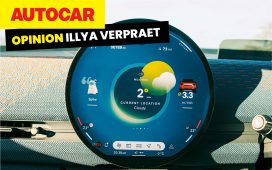Driving high-performance cars on a low friction, frozen surface is more about technique than pure car control.
Sub-zero temperatures are not what we tropical folks are used to, but for what we were about to do in the Austrian Tyrol, it couldn’t have been any warmer. Or more breathtaking. On a frozen field surrounded by rugged Alpine mountains, I was all set to drive a pair of Audis on ice and the temperature readout of -7 degrees on the dashboard reassured us that the thick layer of ice that the studded winter tyres would claw into, wasn’t about to melt.
Austrian Tyrol is a winter wonderland of unspoiled beauty.
Welcome to the Audi Ice Experience, a one-for-the-bucket list experience carefully curated by the German luxury brand. For Audi, selling cars is not enough. It also provides experiences its customers (and us media) will never forget, and this two-day Ice driving programme, set in an unspoiled winter wonderland near Seefeld in Austria, is one of them. It’s a surreal feeling drifting and sliding powerful Audis all day long on a surface that’s as slippery as a bar of soap on a wet bathroom floor, in a completely white and pristine landscape, and then having rabbit for dinner.
It’s hard to judge how cold – 7 or -10 degrees really is because we never experience such freezing temperatures. So I played safe and brought enough warm clothes to keep a family of polar bears snug. Thankfully, there was no wind chill, and I didn’t need to layer up too much, which is just as well because, on a programme that involves driving on the edge, you want to be comfortable and not burdened by heavy clothing.
Stunning scenery and some very fast Audis serve up an unforgettable experience.
A fleet of Audi RS e-tron GTs and RS5s neatly lined up on an icy field await us for two days of drifting, sliding, understeering, oversteering, wheel spinning and occasional pirouetting. Any ice driving experience is basically a workshop to teach you the physics of car control and discover the limits of your car at ridiculously slow speeds in an open and safe environment. But the cars we are driving are not exactly slow. The RS e-tron GT is Audi’s fastest and most powerful EV, producing 598hp and 830Nm of torque, which gives it a supercar-like 0-100kph time of 3.3 seconds, but that’s on dry tarmac and not here on ice! The e-tron GT represents the car’s future, which, in Europe, will be all-electric by the end of this decade. Flying the flag for good old internal combustion before it’s gone is the Audi RS5 with its delectable three-litre V6 that develops a juicy 450hp and 600Nm of torque. These figures are considerably lower than the e-tron GT’s, but the RS5 is a good 550kg lighter. And weight, as we soon discovered, has an acute impact on your ability to control a car.
Breaking the ice
Cones are neatly laid out to demarcate multiple tracks and the only thing you can really hit on this wide, long and flat ice field, which is free of any obstructions, are just the cones. So, there’s lots of run-off areas to safely make mistakes.
For Fast and Furious style drifting, your right pedal is your second steering.
Piece of cake, then? That’s what I think until I step out onto the ice and almost go for a toss. If the ice is so slippery to walk on, what must it be like to drive on? The Audis certainly have more grip than my Hush Puppies thanks to the Lappi-studded tyres they are fitted with and Audi’s legendary Quattro system that deftly balances traction between all four wheels. But, despite all that tech, grip levels are so low that even a mild prod of the accelerator pedal can provoke a slide.
Driving on ice is more about technique than pure car control and there are couple things you need to know. Firstly, grip is much more important than power and within the first 10 metres, this becomes pretty clear. Secondly, weight transfer is a key technique to smoothly turn the car without losing control, and this is what our two brilliant instructors, Harald and Ian, try to drill into our heads. It involves abruptly lifting off the accelerator pedal and turning the wheel. This chucks the weight to the nose so the front tyres dig into the ice, while the rears go light and gently lose grip to neatly bring the tail out. Easier said than done! Any fumbling behind the wheel does not miss the trained eye of either instructor who jumps on the walkie-talkie to politely tell us what we are doing wrong.
Eagled-eyed instructors are quick to correct us.
To get us warmed up, the first course is a small loop that combines a simple slalom and a couple of corners. It’s pretty low-speed stuff, but enough to get a good feel of both cars, which, from the get-go feel remarkably different. The bigger and heavier RS e-tron GT is a bit of a handful and you need to be extremely precise with every steering and accelerator input. To get the hang of things, we first drive with the traction control on, but even then, a small prod of the right pedal makes the RS e-tron GT slither and squirm, the traction control light furiously blinking away to show it’s doing its job. The RS5 is far more agile and forgiving, and hence, easier to skate through the tight and slippery course.
Next up are lane change exercises to test the stability systems and anti-lock brakes in both cars. It’s pretty straightforward stuff and even with the traction control off both the RS e-tron GT and RS5 stoically go through the double lane change manoeuvers with just a bit of a tail wag. If you like driving, you won’t like understeer, which is why an understeer-inducing exercise in the RS e-tron GT to understand what it feels like when your front tyres lose grip first was the least exciting part of the day.
RS e-tron GTs are exhilarating to drive on low friction surface.
Balancing act
The real fun starts with the oversteer exercise in the RS5 because rotating a car with the throttle and hanging the tail out makes you feel like a hero. However, inducing oversteer isn’t that easy. It needs commitment to keep your right foot in there and catch the slide with armfuls of opposite lock. Be hesitant or half-hearted with the throttle and you end up understeering like an also-ran. The good thing is that unlike the RS e-tron GT, the RS5 is happy to slide and so we head to the drift pad for the most exciting exercise of the day, drifting around a tight circular course.
For Fast and Furious style drifting, the throttle pedal is your second steering to swivel the car around its axis. Ease off the throttle and you’ll immediately lose the drift and if you’re too brutal, you’ll spin. I manage to balance throttle and steering and feel like a drift champion holding lurid power slides for a couple of laps, looking more out of the side window than the windscreen. What a high this was!
Studded tyres maximise traction on ice.
The toughest but most satisfying (if you get it right) exercise was a fast slalom in the RS e-tron GT, which truly tests your skills. It’s best not to use the brakes, but, instead, rely on the weight transfer to pivot the car. But, in a car weighing 2,345kg, that’s a lot of weight to transfer from the front to the rear wheels, so the car can get a bit unwieldy. Here’s where the theory comes into proper practice. Lift off, move the weight to the front, delicately turn the wheel, give a sharp dab of the accelerator pedal to bring the tail out, quickly apply opposite lock to straighten out for the next set of cones. Repeat.
Because the heavy RS e-tron GT has quite a bit of inertia, it tends to understeer heavily and then snap into oversteer. The trick is to apply corrective action before you think you need to, but this doesn’t come to you naturally. The few times I got it right – flicking the big RS e-tron GT through the slalom like a switchblade on the icy track without going too sideways or into a spin – elicited a ‘Bravo’ from our ever-watchful instructor, and made my day.
The last session of the day was a timed run over two laps on a specially laid-out course for all of us media. The course had a mix of slalom, tight corners and some pretty fast bends. This was the time to put all the theory into practice, and remember what Harald and Ian have been telling us for two days. But, when you’re up against the clock, the seat of your pants takes over and you drive by instinct. I wasn’t too bad in the RS5, just a few tenths shy of the fastest man, Sirish Chandran of Evo. But we both clipped a cone, which meant disqualification from the ‘official’ standings. Whilst the RS5 was a baby, the RS e-tron GT on the same course was quite a handful, and I overcooked it on one of the slaloms and blew my chances of a good time with a semi-spin. No such mistakes for GQ’s Parth Charan, who whipped all the seasoned drivers by setting the fastest time of the day in the super-quick RS e-tron GT.
What you take away back to sunny India after two days on ice is that driving on a frozen, ultra-low grip surface requires different skills and techniques compared to driving on normal roads. But the good thing is even when you spin out of control, you don’t have to worry about hitting anything. The only danger is of slipping and falling when you step out of the car.










